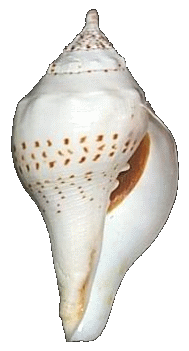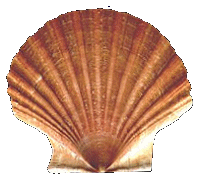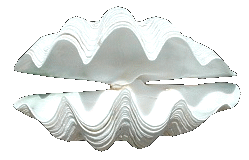6.Religion:
Shells have played a central
role in religion from prehistoric times on. Dominating early religious
practices, cowry shells (Cypraea) had powerful symbolism
(basically sexual, for they were first and foremost a female symbol) and
this was renewed in the religions of the great civilizations that followed.
The presence of shells in prehistoric burial places indicate that their
symbolic power was believed to continue beyond life.
Shells in some cultures even
today are used as amulets, good luck charms, and as symbols for love,
fertility and life eternal.
Some examples of some these religious practices are:
- Africa:
Shells fetishes were often used in worship. Ceremonial garbs are many
times decorated with shells and were used in some religious ceremonies.
(Note: a "fetish" an object which is treated with reverence and respect because it is either thought to have special powers, or is where a god or spirit lives or is present in some special manner)
- North American Indians also made fetishes of shells. The Canadian Ojibwa tribe maintained a Grand Medicine Society in which the sacred emblem was a shell.
 Turbinella pyrum Indian Chank Shell(right-handed) |
India:
Hindus: The god Vishnu holds his staff crowned with a very rare left-handed
Turbinella ("Chank") shell The Hindu, when
praying, often clasps a sacred chank or other venerated object in
his hands, believing that it will help his or her petitions be heard.
Priests also use it for holding sacred oils. (Note: Hold a shell up, with the siphon (the open end) down. Most shells will open to the right. Sometimes, a specimen will coil the other way; so it opens to the left - so we can say shells are "right-handed and left-handed - or, "dextral" and "sinistral". Most Chank shells are right handed, so the left-handed ones are rare, and venerated.) ( See some great pictures) |
- Asia:
Buddhists: The Chank or Turbinella also plays a significant
role in their ritual music and ceremonies, and figures into Buddhist
iconography.
- Spain: The home of the shrine of Santiago(St. James). St. James's badge is the Giant European scallop shell (Pecten jacobaeus). Pilgrims to this shrine purchased the simple but exquisitely sculptured scallop shells and wore them as a sign of their pilgrimage to the shrine. This scallop also appears in many paintings and statues of this saint throughout Europe.

Pecten jacobaeus
(Linnaeus, 17598)
- Egypt,
China and other cultures used the cowry in connection with their
burials and other religious ceremonies.
NOTE: To see photos of New Guineans wearing tribal costumes, click HERE
- Sierra Leone: Cannibals during the nineteenth century used cowry shells in part of their ceremonial rituals.
- Pre-Columbian South and Central America:Archaeological sites have produced shell trumpets that may have played a role in religious ceremonies. In the Andes region, a Thorny Oyster (Spondylus princeps (Broderip)), and the giant E. Pacific conch (Strombus galeatus Linne) as well as Pinctada atlanticus (a Winged Oyster) all had important religious significance. The Aztecs of Mexico also used shells in their religion: Tlaloc, the rain god, is depicted as emerging from a conch (Strombus spp) shell. They also used conch and horse conch (Pleuroploca) shell trumpets.
- Minoan Crete: Shell trumpets were used in religious ceremonies.
 |
Christianity: Many churches had or still have baptismal fonts made of Tridacna gigas Linne) (the famous "Giant Clam"!) or are designed in their likeness. They are though to be a symbol of birth. |